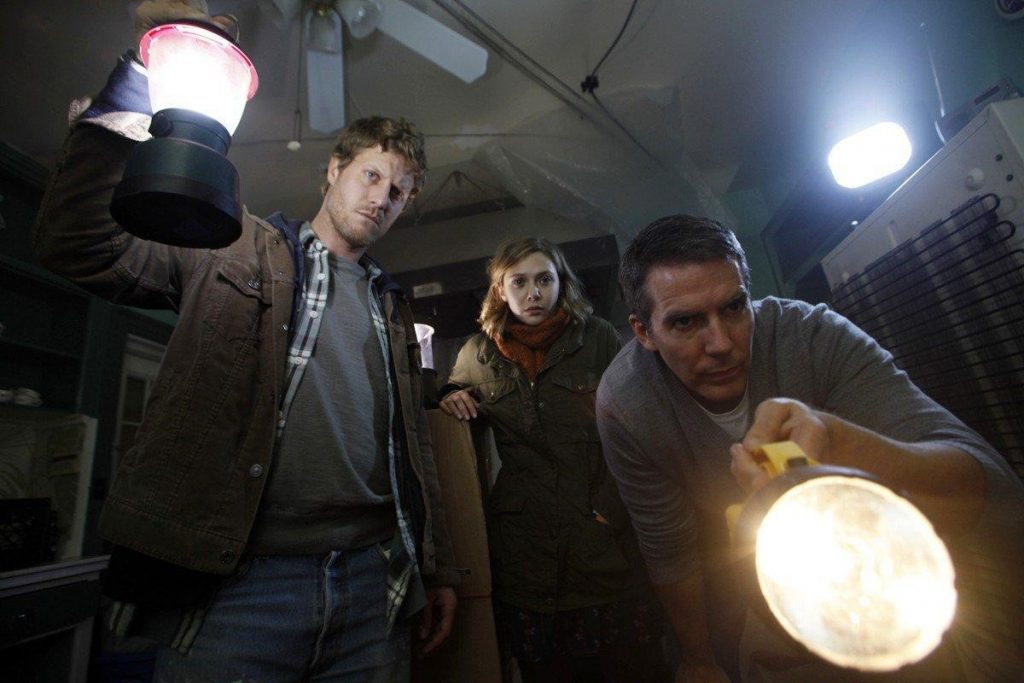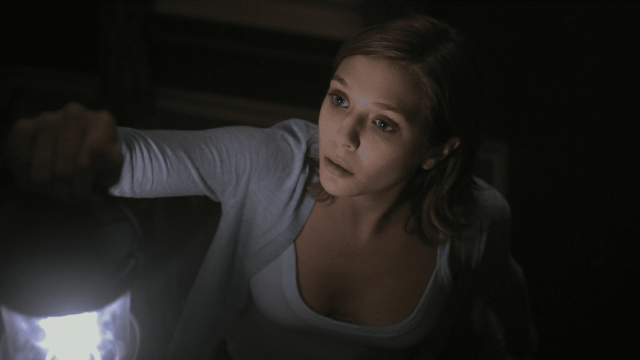Since Cinemascore began operation in 1979 only 19 films have received the lowest score. In this series I’ll be reviewing those 19 films. This week, the horror film that bridges the gap between the low-fi herky-jerky found footage era and the slow pretentious art-house era.
So What is it?
The trailer for Silent House promises “the most shocking and twisted incident ever recorded,” a bold claim for a movie that is a direct remake of a film released a mere twelve months earlier. Both Silent House and the original La Casa Muda claim to be based on true stories, although Wikipedia diplomatically states that “[La Casa Muda] is supposedly inspired by real events that took place in the 1940s, but no information can be found to authenticate the aforementioned claims” and the remake changes the nationality, basic relationships, backstory, and motivation, of its characters as well as the country and decade that the story takes place in. Well, in any case, it’s certainly true that there are houses and sometimes people are in them.
Right off the bat, La Casa Muda seems like a poor choice for a remake. The film was a mild success, with critics appreciating the technical skill of the director (particularly considering its meger $6,000 budget) but found the story generic and unsatisfying. And while the film is in Spanish, it makes sparse use of dialogue and could probably be enjoyed just fine sans-subtitles. And it wasn’t even a year old! No time for it to build a cult following that could be exploited,or slip from the public consciousness enough for a nostalgic reimagining. This is just a moderately bigger studio bulldozing over a scrappy foreign filmmaker. Shed no tears for Gustavo Hernández though, he’s still working and Kentis and Lau are not.
Both versions of the film follow basically the same structure and are built around the same gimmick. The film is all a (simulated) single take, watching the events unfold in realtime. In Birdman (released a few years later), the single take gives the movie a stream-of-consciousness vibe. By manipulating time and space without breaking the “shot” the film foregrounds its artificiality, pushing the audience towards a subjective reading, while also putting us in the sleep-deprived headspace of the protagonist. Rope uses its single take to try and replicate the effect of the live theater play it was based on, in which the first thing we see is a body being hidden on stage that most of the characters will be unaware of throughout the show. This doesn’t really work. The effect depends on the audience sharing the same physical space with the body, and our attention isn’t split between the corpse and the mundane snobbish dinner party because Hitchcock’s camera is still controlling our focus. Silent House is more of a true gimmick movie, in that the single take doesn’t have much purpose at all in the film other than to impress particularly knowledgeable audience members. But a movie doesn’t need to justify its style, and although the single take isn’t necessary, it’s still neat.
Storywise this is a very simple movie. A young woman (Elizabeth Olson enjoying her brief moment of freedom between her breakout performance in Martha Marcy May Marlene and her indentured servitude to the Marvel machine) goes with her father and uncle to fix up her childhood home. The house has no electricity and all the doors and windows have been boarded up, meaning that the characters have to use underpowered flashlights and lanterns (often held just beneath faces because a cliche’s not a cliche if it works) in order to navigate the dark muddy grey space. After an awkward incestuously charged moment, her uncle makes a run to the hardware store, and Olson is left alone with her father (who also seems to be checking her out a couple of times. This is the sort of thing that most movies are able to edit around). Soon there are strange noises coming from the house and when Olson’s father investigates he disappears only to materialize later, badly injured, unconscious, but still alive. It turns out THERE’S SOMEONE IN THE HOUSE, and what’s worse, with all the doors and windows boarded up and padlocked, Olson can’t just make a run for it.
The film was shot on location in a massive labyrinthine estate, with three stories and a basement that looks like a cross between a chemical processing plant and a medieval dungeon. The main floor exits to one of those giant old porches that you hardly ever see outside of Civil War movies, and the basement also has a door that exits to the (presumably haunted) woods. There’s a pair of twin staircases leading upstairs, and an impossible number of rooms, all of which seem to have three or four different entrances and exits and a shortage of hallways, meaning that everyone needs to navigate through these rooms to get anywhere. I can’t imagine this was built for any purpose other than concealing ghosts and/or axe murderers.
Silent House is directed by the husband and wife team of Chris Kentis and Laura Lau, and as in their previous film Open Water, they favor an intense and minimalist style of horror. The single shot conceit means that we are watching the film through a single hand held camera that is almost always pointed directly at Olson’s face, and we follow her actions in agonizing realtime. She hides under a table, struggling not to scream or cry or make any noise at all, while her attacker walks around only a few feet from her, and we watch this struggle inches from her mouth. She fumbles with keys and padlocks,and we hear every little noise, see every bit of frustration, have to time out the whole process along with her. Eventually she escapes the house, and the cameraman runs alongside her through the woods as she slowly gets overcome with exhaustion. It’s a boring scene, and slightly nauseating (“Fortunately this camera operator was a parkour guy.” Lau tells us on the commentary, as though we weren’t already aware.) But the effect is something you can’t fake. That’s real exhaustion. Olson really is pushing herself past her limits. At the end of that sequence she’s picked up by her uncle, who drives her right back to the house, and you can viscerally feel all the hard fought progress being effortlessly undone.
Olson’s uncle has a gun, and he tells her that they’re going to grab her father and go get help.This is a sound plan, but there wouldn’t be much of a movie if it worked, so after a few jump scares and some general confusion, the uncle finds himself shot in the stomach. Olson takes his gun and unloads on the intruder at pointblank range, but manages to totally miss him. She flees and hides under a bed, more or less hopelessly. Under the bed there is also a little girl, who signals for her to stay quiet before being yanked offscreen by some unseen force. Olson scrambles out, and sees the the bed itself has started bleeding. She runs to the bathroom, where a little girl is in the tub with beer bottles floating around her, and there’s a toilet mounted to the wall. Looking back down, the tub is filled with blood and the toilet also starts spewing blood. While many horror movies incorporate surrealist elements, few do so after spending so much time establishing their realism. There’s not even a dream sequence cop out, here! This shit happened, and Olson will have to deal with it.
Going down stairs she finds her dad tied to a chair and wrapped in plastic. She begins acting strangely, flitting through different personalities, and we learn that the intruders were just projections. In another twist, it turns out that that wasn’t bad acting from earlier, that her dad and uncle had molested her as a child. Her dad pleads for her to untie him, and when she does he takes his belt off and starts spanking her with it, as she flits to a much more submissive personality, and her uncle pleads with his brother to go easy on her. In a shocking twist this hasn’t been a somber miserabilist psychological thriller, this has been gonzo trash horror all along! Olson takes a sledge hammer and bashes her dad to death, and then leaves her uncle to bleed out, and that’s the end of the movie, folks. What did you think?
So Why the F?
It’s that twist. While something that preposterous, tasteless, and cliched would be a hard sell under any circumstances, here it comes in a movie that has built up an incredible amount of audience identification with its victim/killer. On top of that the movie has put so much emphasis on its realism – supposedly based on a true story, shot in real time, in a quiet minimalist manner, with a horrifying but mundane threat, and a ton of attention paid to the protagonist’s emotional state – that it comes as a double betrayal to anyone engrossed in the story. This is not just pulling the rug out from under the audience, this is tearing up the floorboards and digging up the foundation. People are hostile enough with misleading trailers. Changing the genre when you’re already an hour into an 88 minute movie is asking for a riot.
So Were they right?
No! That twist is great. The surrealism is incredibly unnerving exactly because the film has spent so much time establishing it’s reality, and for the last twenty minutes the movie could go anywhere. The first hour is competent and effective, and Olson in particular is doing great work in what had to have been an absolutely grueling role to perform. But despite the difficult shooting process, it’s still a fairly generic, ugly, and miserablist film. How much suffering do you want to watch Elizabeth Olson endure? And despite the somber tone and artsy affectations, this is still a pretty dumb movie, where the real threat is everyone’s lack of basic communication skills. That twist is trashy as hell, but it’s also fun and weird and engaging, and it makes the movie worth seeing. Although now that you know the twist is there, it’s probably not worth seeing anymore.

Next Time: Lindsay Lohan knows who killed her career.

